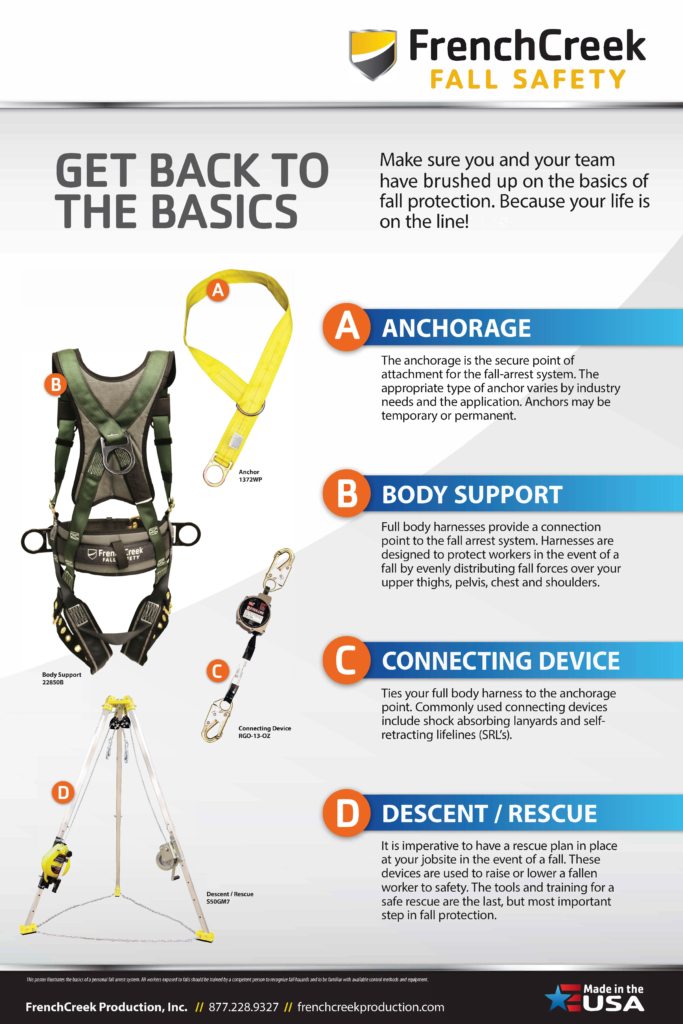Fall Prevention vs. Fall Protection
Fall prevention and fall protection are often used interchangeably, but they are very different in how they protect workers. The first of these, fall prevention, is the process of preventing falls from occurring by eliminating or minimizing the potential of fall hazards. This can be achieved through systems, such as guardrails, covers, or nets. Fall protection, on the other hand, involves the use of personal protective equipment (PPE) to protect workers during a fall. Fall protection systems typically include harnesses, lifelines, and anchors.
Types of Fall Prevention Systems
There is a wide range of equipment that can function as fall prevention. Any equipment that passively protects workers from unprotected fall hazards can be classified as fall prevention. Systems such as guardrails, automatic gates, restraining lifelines, and covers can prevent workers from being within hazard zones. Many of these systems can function as temporary solutions during construction or as permanent features.
- Guardrails: Guardrails are barriers that prevent workers from accidentally stepping off an elevated surface, such as a platform or roof. Guardrails must meet specific OSHA regulations regarding height, strength, and construction materials.
- Covers: Eliminating fall hazards by covering holes on elevated surfaces is a simple yet effective way of preventing a fall. Holes such as vault entrances, confined spaces, and skylights can be covered. The cover must be able to support the weight of any equipment or workers that may operate on them.
- Gates: The primary means of preventing a fall with a gate is simply keeping people away from ledges or work areas that are not secure.
- Restraint Lifelines: The use of a lifeline to restrain movement is an effective way to prevent a fall. A common workplace to find restraint lifelines is on rooftops as they allow workers to move throughout an area while physically preventing them from getting close to an edge.
Types of Fall Protection Systems
Unlike a fall prevention system, fall protection equipment comes into effect during a fall. Full-body harnesses, lanyards, anchors, and self-retracting lifelines are all pieces of fall protection equipment. The primary goal of fall protection equipment is to minimize the dangers presented by a fall. This is done by controlling fall arrest forces by quickly stopping a fall.
- Fall protection harnesses: A full-body harness protects users by spreading the force of a fall throughout all of a user’s body rather than allowing it to remain concentrated in one area. This significantly reduces the potential injuries a fallen worker will receive.
- Horizontal lifelines: A horizontal lifeline is a fall protection system that is designed to provide continuous protection for workers who need to move along a horizontal surface. A horizontal lifeline typically consists of a cable or rope that is attached to anchor points on either end of the work area.
- Lanyards and SRL’s: Both of these options serve the same purpose. Connected to the worker’s back, lanyards and SRL’s are what slow and stop a fall.
- Confined Space Systems: A portable davit system or a confined space tripod are both commonly used fall protection systems. They allow workers entering a confined space to have both a working winch and a three-way rescue unit attached to them. They also provide the added benefit of allowing users to remove injured or unconscious workers from spaces such as manholes far easier then if they did not have these systems.
- Vertical Ladder Systems: Fixed ladders are equipped with fall protection systems designed to quickly stop falls. Vertical cable and rail systems can stop a fall within moments preventing the worker from getting caught in rungs or falling to a lower level. In the past ladder, cages were considered proper fall protection but years of observations have proven that they are ineffective and even dangerous to falling workers. Fixed ladders 24’ or taller are required by OSHA to have a ladder safety system installed.
ABC’s of fall protection
Having both fall prevention and protection systems is essential to workplace safety. Utilizing a combination of fall prevention and fall protection systems together is the best way to reduce the dangers of working at height. One way that workers can remember the difference between a fall prevention device and a fall protection device is with the ABC’s of Fall Protection.
A- Anchorage: There is a large variety of specialized anchors made to keep workers safe in every workplace. These include simple tie-off anchors to sliding anchors and beam trolly systems. These connectors can be separated into two categories, certified and non-certified anchors. For more information on certified vs. non-certified anchors, you can read This Article Here.
B- Body Wear: The focus of this section is the full-body harness. Since harnesses mitigate fall arrest forces on the wearer, they are a part of the fall protection category of equipment.
C- Connecting Device: Equipment such as lanyards and self-retracting lifelines fall into this category of fall protection. They are the physical connection between a worker’s harness and the anchor point they are using. Connecting devices stop falls and aid in reducing fall arrest forces.
